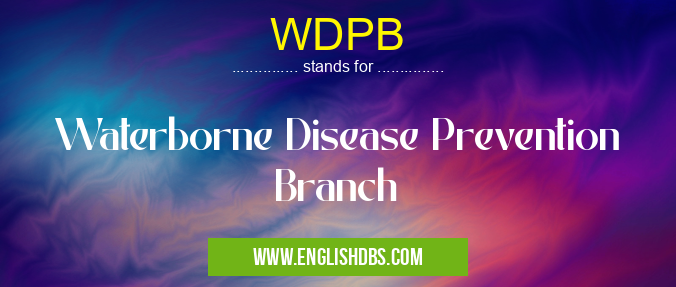What does WDPB mean in DISEASES
WDPB stands for Waterborne Disease Prevention Branch. It is a specialized branch within public health agencies dedicated to preventing and controlling waterborne diseases.

WDPB meaning in Diseases in Medical
WDPB mostly used in an acronym Diseases in Category Medical that means Waterborne Disease Prevention Branch
Shorthand: WDPB,
Full Form: Waterborne Disease Prevention Branch
For more information of "Waterborne Disease Prevention Branch", see the section below.
Functions of WDPB
The WDPB plays a crucial role in protecting public health by:
- Surveillance and Monitoring: Tracking and analyzing data to identify potential waterborne disease outbreaks.
- Investigation and Outbreak Response: Conducting investigations and implementing control measures to contain and mitigate outbreaks.
- Water Quality Assessment: Evaluating the quality of water sources, including drinking water, recreational water, and wastewater, to ensure compliance with safety standards.
- Education and Outreach: Educating the public about waterborne diseases, their prevention, and the importance of safe water practices.
- Policy Development: Developing and implementing policies and guidelines to prevent waterborne disease transmission.
Essential Questions and Answers on Waterborne Disease Prevention Branch in "MEDICAL»DISEASES"
What is the WDPB responsible for?
The Waterborne Disease Prevention Branch (WDPB) is responsible for preventing waterborne diseases in the United States. The WDPB works to ensure that drinking water is safe, and that recreational water is clean and free of harmful bacteria.
What are some of the waterborne diseases that the WDPB prevents?
The WDPB prevents a variety of waterborne diseases, including:
- Cryptosporidiosis
- Giardiasis
- Legionellosis
- Norovirus
- Salmonella
- Shigella
- Vibrio
How does the WDPB prevent waterborne diseases?
The WDPB prevents waterborne diseases through a variety of methods, including:
- Monitoring drinking water quality
- Inspecting and regulating public water systems
- Providing guidance on safe water treatment and storage
- Educating the public about waterborne diseases and how to prevent them
What can I do to help prevent waterborne diseases?
You can help prevent waterborne diseases by:
- Drinking only treated water
- Avoiding swimming in contaminated water
- Washing your hands frequently with soap and water
- Properly disposing of human waste
- Getting vaccinated against waterborne diseases
Final Words: The WDPB is an essential component of public health infrastructure, working diligently to prevent and control waterborne diseases. Its efforts help protect communities from water-related illnesses and ensure the health and well-being of the population.
